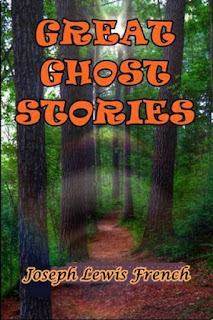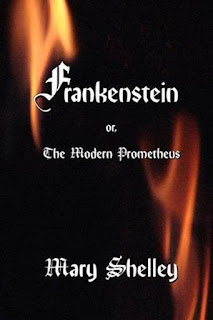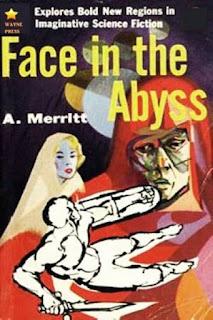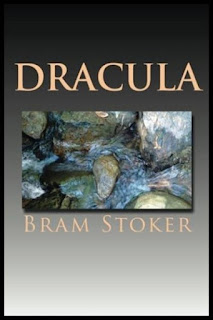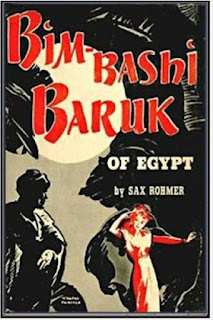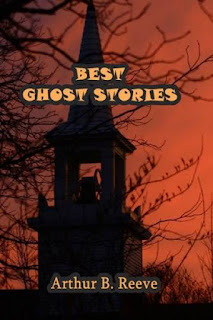All these stories were written in the late eighteen hundreds early nineteen hundreds. Book was originally published in 1918. Contains not only ghost stories, but also, werewolves, vampires, and other denizens of nightmares and the dark. A well rounded collection of old fashioned horror
Tuesday, July 23, 2019
Monday, July 22, 2019
Frankenstein by Mary Shelley. Paperback
The original tale of the most famous monster in literature. Dr. Frankenstein creates a monster in the novel apparently written in a chateaux while Mary Shelly was staying with Shelly and Byron.
Frankenstein; or, The Modern Prometheus is a novel written by English author Mary Shelley (1797-1851) that tells the story of Victor Frankenstein, a young scientist who creates a grotesque but sapient creature in an unorthodox scientific experiment. Shelley started writing the story when she was 18, and the first edition of the novel was published anonymously in London on 1 January 1818, when she was 20. Her name first appeared on the second edition, published in France in 1823.
Shelley travelled through Europe in 1814, journeying along the river Rhine in Germany with a stop in Gernsheim which is 17 km (10 mi) away from Frankenstein Castle, where, two centuries before, an alchemist was engaged in experiments.] Later, she travelled in the region of Geneva (Switzerland)—where much of the story takes place—and the topic of galvanism and other similar occult ideas were themes of conversation among her companions, particularly her lover and future husband, Percy Shelley. Mary, Percy, Lord Byron and John Polidori decided to have a competition to see who could write the best horror story. After thinking for days, Shelley dreamt about a scientist who created life and was horrified by what he had made; her dream later evolved into the novel's story.
Frankenstein is infused with elements of the Gothic novel and the Romantic movement. At the same time, it is an early example of science fiction. Brian Aldiss has argued that it should be considered the first true science fiction story because, in contrast to previous stories with fantastical elements resembling those of later science fiction, the central character "makes a deliberate decision" and "turns to modern experiments in the laboratory" to achieve fantastic results.[5] It has had a considerable influence in literature and popular culture and spawned a complete genre of horror stories, films and plays.
Since the novel's publication, the name "Frankenstein" has often been used to refer to the monster itself. This usage is sometimes considered erroneous, but usage commentators regard it as well-established and acceptable. In the novel, the monster is identified by words such as "creature", "monster", "demon", "wretch," "abortion," and "it". Speaking to Victor Frankenstein, the wretch refers to himself as "the Adam of your labours", and elsewhere as someone who "would have [been] your Adam", but is instead "your fallen angel" (which ties to Lucifer in Paradise Lost, which the monster reads, and relates to the "modern" Prometheus of the book's subtitle).
Shelley travelled through Europe in 1814, journeying along the river Rhine in Germany with a stop in Gernsheim which is 17 km (10 mi) away from Frankenstein Castle, where, two centuries before, an alchemist was engaged in experiments.] Later, she travelled in the region of Geneva (Switzerland)—where much of the story takes place—and the topic of galvanism and other similar occult ideas were themes of conversation among her companions, particularly her lover and future husband, Percy Shelley. Mary, Percy, Lord Byron and John Polidori decided to have a competition to see who could write the best horror story. After thinking for days, Shelley dreamt about a scientist who created life and was horrified by what he had made; her dream later evolved into the novel's story.
Frankenstein is infused with elements of the Gothic novel and the Romantic movement. At the same time, it is an early example of science fiction. Brian Aldiss has argued that it should be considered the first true science fiction story because, in contrast to previous stories with fantastical elements resembling those of later science fiction, the central character "makes a deliberate decision" and "turns to modern experiments in the laboratory" to achieve fantastic results.[5] It has had a considerable influence in literature and popular culture and spawned a complete genre of horror stories, films and plays.
Since the novel's publication, the name "Frankenstein" has often been used to refer to the monster itself. This usage is sometimes considered erroneous, but usage commentators regard it as well-established and acceptable. In the novel, the monster is identified by words such as "creature", "monster", "demon", "wretch," "abortion," and "it". Speaking to Victor Frankenstein, the wretch refers to himself as "the Adam of your labours", and elsewhere as someone who "would have [been] your Adam", but is instead "your fallen angel" (which ties to Lucifer in Paradise Lost, which the monster reads, and relates to the "modern" Prometheus of the book's subtitle).
- Published
- December 13, 2018
- Language
- English
- Pages
- 262
- Binding
- Perfect-bound Paperback
- Interior Ink
- Black & white
- Weight
- 0.21 lbs.
- Dimensions (inches)
- 4.25 wide x 6.88 tall
Sunday, July 21, 2019
Frankenstein by Mary Shelley.
Frankenstein; or, The Modern Prometheus is a novel written by English author Mary Shelley (1797-1851) that tells the story of Victor Frankenstein, a young scientist who creates a grotesque but sapient creature in an unorthodox scientific experiment. Shelley started writing the story when she was 18, and the first edition of the novel was published anonymously in London on 1 January 1818, when she was 20. Her name first appeared on the second edition, published in France in 1823.
Shelley travelled through Europe in 1814, journeying along the river Rhine in Germany with a stop in Gernsheim which is 17 km (10 mi) away from Frankenstein Castle, where, two centuries before, an alchemist was engaged in experiments.] Later, she travelled in the region of Geneva (Switzerland)—where much of the story takes place—and the topic of galvanism and other similar occult ideas were themes of conversation among her companions, particularly her lover and future husband, Percy Shelley. Mary, Percy, Lord Byron and John Polidori decided to have a competition to see who could write the best horror story. After thinking for days, Shelley dreamt about a scientist who created life and was horrified by what he had made; her dream later evolved into the novel's story.
Frankenstein is infused with elements of the Gothic novel and the Romantic movement. At the same time, it is an early example of science fiction. Brian Aldiss has argued that it should be considered the first true science fiction story because, in contrast to previous stories with fantastical elements resembling those of later science fiction, the central character "makes a deliberate decision" and "turns to modern experiments in the laboratory" to achieve fantastic results. It has had a considerable influence in literature and popular culture and spawned a complete genre of horror stories, films and plays.
Since the novel's publication, the name "Frankenstein" has often been used to refer to the monster itself. This usage is sometimes considered erroneous, but usage commentators regard it as well-established and acceptable. In the novel, the monster is identified by words such as "creature", "monster", "demon", "wretch," "abortion," and "it". Speaking to Victor Frankenstein, the wretch refers to himself as "the Adam of your labours", and elsewhere as someone who "would have [been] your Adam", but is instead "your fallen angel" (which ties to Lucifer in Paradise Lost, which the monster reads, and relates to the "modern" Prometheus of the book's subtitle).
Shelley travelled through Europe in 1814, journeying along the river Rhine in Germany with a stop in Gernsheim which is 17 km (10 mi) away from Frankenstein Castle, where, two centuries before, an alchemist was engaged in experiments.] Later, she travelled in the region of Geneva (Switzerland)—where much of the story takes place—and the topic of galvanism and other similar occult ideas were themes of conversation among her companions, particularly her lover and future husband, Percy Shelley. Mary, Percy, Lord Byron and John Polidori decided to have a competition to see who could write the best horror story. After thinking for days, Shelley dreamt about a scientist who created life and was horrified by what he had made; her dream later evolved into the novel's story.
Frankenstein is infused with elements of the Gothic novel and the Romantic movement. At the same time, it is an early example of science fiction. Brian Aldiss has argued that it should be considered the first true science fiction story because, in contrast to previous stories with fantastical elements resembling those of later science fiction, the central character "makes a deliberate decision" and "turns to modern experiments in the laboratory" to achieve fantastic results. It has had a considerable influence in literature and popular culture and spawned a complete genre of horror stories, films and plays.
Since the novel's publication, the name "Frankenstein" has often been used to refer to the monster itself. This usage is sometimes considered erroneous, but usage commentators regard it as well-established and acceptable. In the novel, the monster is identified by words such as "creature", "monster", "demon", "wretch," "abortion," and "it". Speaking to Victor Frankenstein, the wretch refers to himself as "the Adam of your labours", and elsewhere as someone who "would have [been] your Adam", but is instead "your fallen angel" (which ties to Lucifer in Paradise Lost, which the monster reads, and relates to the "modern" Prometheus of the book's subtitle).
Friday, July 19, 2019
Four Weird Tales by Algernon Blackwood.
Strange and chilling, these are four stories by the master of the macabre for you to consider. Blackwood's name is synonomous with the strange.
Strange and chilling, these are four stories by the master of the macabre for you to consider. Blackwood's name is synonomous with the strange.
This EPUB is readable on all devices and
on every web browser on every computer and cell phone. Kindle, Nook,
Ipod, Ipad, Android, Windows, and Mac all support this format. This EPUB
has no encryption, so one can safely and easily move it from one device
to another, or share it with others.
Algernon Blackwood was one of the world's foremost horror and ghost-tale writers. His works can be found HERE.
Saturday, July 13, 2019
A treasury hunting expedition is lost in the jungle. A lost civilization is discovered. It is a land with incredible people, devices and powers from ancient times. There is a struggle, in that land, going on between good and evil. One of the adventurer-goers is destined to aid in that struggle. He fights for the life of that civilization, his life, and a girl he loves. A thrilling science fiction horror pulp tale in the vein of H. P. Lovecraft.
Saturday, July 6, 2019
Bram Stoker's priceless classic of horror and romance.
Dracula is an 1897 Gothic horror novel by Irish author Bram Stoker. It introduced the character of Count Dracula, and established many conventions of subsequent vampire fantasy The novel tells the story of Dracula's attempt to move from Transylvania
to England so that he may find new blood and spread the undead curse,
and of the battle between Dracula and a small group of men and a woman
led by Professor Abraham Van Helsing.
Dracula has been assigned to many literary genres including vampire literature, horror fiction, the gothic novel, and invasion literature. The novel has spawned numerous theatrical, film, and television interpretations.
The story is told in an epistolary format, as a series of letters, diary entries, newspaper articles, and ships' log entries, whose narrators are the novel's protagonists, and occasionally supplemented with newspaper clippings relating events not directly witnessed. The events portrayed in the novel take place chronologically and largely in England and Transylvania during the 1890s and all transpire within the same year between 3 May and 6 November. A short note is located at the end of the final chapter written 7 years after the events outlined in the novel.
The tale begins with Jonathan Harker, a newly qualified English solicitor, visiting Count Dracula at his castle in the Carpathian Mountains on the border of Transylvania, Bukovina, and Moldavia, to provide legal support for a real estate transaction overseen by Harker's employer, Mr Peter Hawkins of Exeter. At first enticed by Dracula's gracious manners, Harker soon realizes that he is Dracula's prisoner. Wandering the Count's castle against Dracula's admonition, Harker encounters three female vampires, called "the sisters", from whom he is rescued by Dracula. Harker soon realizes that Dracula himself is also a vampire. After the preparations are made, Dracula leaves Transylvania and abandons Harker to the sisters. Harker barely escapes from the castle with his life.
Dracula boards a Russian ship, the Demeter, taking along with him boxes of Transylvanian soil, which he required in order to regain his strength. Not long afterward, the ship having weighed anchor at Varna, runs aground on the shores of Whitby in the east coast of England. The captain's log narrates the gradual disappearance of the entire crew, until the captain alone remained, himself bound to the helm to maintain course. An animal resembling "a large dog" is seen leaping ashore. The ship's cargo is described as silver sand and 50 boxes of "mould", or earth, from Transylvania. It is later learned that Dracula successfully purchased multiple estates under the alias 'Count De Ville' throughout London and devised to distribute the 50 boxes to each of them utilizing transportation services as well as moving them himself. He does this to secure for himself "lairs" and the 50 boxes of earth would be used as his graves which would grant safety and rest during times of feeding and replenishing his strength.
Harker's fiancée, Mina Murray, is staying with her friend Lucy Westenra, who is holidaying in Whitby. Lucy receives three marriage proposals from Dr. John Seward, Quincey Morris, and Arthur Holmwood (the son of Lord Godalming who later obtains the title himself. Lucy accepts Holmwood's proposal while turning down Seward and Morris, but all remain friends. Dracula communicates with Seward's patient, Renfield, an insane man who wishes to consume insects, spiders, birds, and rats to absorb their "life force". Renfield is able to detect Dracula's presence and supplies clues accordingly.
Soon Dracula is indirectly shown to be stalking Lucy. As time passes she begins to suffer from episodes of sleepwalking and dementia, as witnessed by Mina. When Lucy begins to waste away suspiciously, Seward invites his old teacher, Abraham Van Helsing, who immediately determines the true cause of Lucy's condition. He refuses to disclose it but diagnoses her with acute blood-loss. Van Helsing prescribes numerous blood transfusions to which he, Seward, Quincey, and Arthur all contribute over time. Van Helsing also prescribes garlic flowers to be placed throughout her room and weaves a necklace of withered garlic blossoms for her to wear. However she continues to waste away – appearing to lose blood every night. While both doctors are absent, Lucy and her mother are attacked by a wolf and Mrs. Westenra, who has a heart condition, dies of fright. Van Helsing attempts to protect her with garlic but fate thwarts him each night, whether Lucy's mother removes the garlic from her room, or Lucy herself does so in her restless sleep. The doctors have found two small puncture marks about her neck, which Dr. Seward is at a loss to understand. After Lucy dies, Van Helsing places a golden crucifix over her mouth, ostensibly to delay or prevent Lucy's vampiric conversion. Fate conspires against him again when Van Helsing finds the crucifix in the possession of one of the servants who stole it off Lucy's corpse.
Following Lucy's death and burial, the newspapers report children being stalked in the night by a "bloofer lady" (i.e., "beautiful lady"). Van Helsing, knowing Lucy has become a vampire, confides in Seward, Lord Godalming, and Morris. The suitors and Van Helsing track her down and, after a confrontation with her, stake her heart, behead her, and fill her mouth with garlic. Around the same time, Jonathan Harker arrives from Budapest, where Mina marries him after his escape, and he and Mina join the campaign against Dracula.
The vampire hunters stay at Dr. Seward's residence, holding nightly meetings and providing reports based on each of their various tasks. Mina discovers that each of their journals and letters collectively contain clues to which they can track him down. She tasks herself with collecting them, researching newspaper clippings, fitting the most relevant entries into chronological order and typing out copies to distribute to each of the party which they are to study. Jonathan Harker tracks down the shipments of boxed graves and the estates which Dracula has purchased in order to store them. Van Helsing conducts research along with Dr. Seward to analyze the behaviour of their patient Renfield who they learn is directly influenced by Dracula. They also research historical events, folklore, and superstitions from various cultures to understand Dracula's powers and weaknesses. Van Helsing also establishes a criminal profile on Dracula in order to better understand his actions and predict his movements. Arthur Holmwood's fortune assists in funding the entire operation and expenses. As they discover the various properties Dracula had purchased, the male protagonists team up to raid each property and are several times confronted by Dracula. As they discover each of the boxed graves scattered throughout London, they pry them open to place and seal wafers of sacramental bread within. This act renders the boxes of earth completely useless to Dracula as he is unable to open, enter or further transport them.
After Dracula learns of the group's plot against him, he attacks Mina on three occasions, and feeds Mina his own blood to control her. This curses Mina with vampirism and changes her but does not completely turn her into a vampire. Van Helsing attempts to bless Mina through prayer and by placing a wafer of sacrament against her forehead, but it burns her upon contact leaving a wretched scar. Under this curse, Mina oscillates from consciousness to a semi-trance during which she perceives Dracula's surroundings and actions. Van Helsing is able to use hypnotism twice a day, at dawn and at sunset, to put her into this trance to further track Dracula's movements. Mina, afraid of Dracula's link with her, urges the team not to tell her their plans out of fear that Dracula will be listening. After the protagonists discover and sterilize 49 boxes found throughout his lairs in London, they learn that Dracula has fled with the missing 50th box back to his castle in Transylvania. They pursue him under the guidance of Mina. They split up into teams once they reach Europe; Van Helsing and Mina team up to locate the castle of Dracula while the others attempt to ambush the boat Dracula is using to reach his home. Van Helsing raids the castle and destroys the vampire "sisters". Upon discovering Dracula being transported by Gypsies, the three teams converge and attack the caravan carrying Dracula in the 50th box of Earth. After dispatching many Gypsies who were sworn to protect the Count, Harker shears Dracula through the throat with a kukri knife, while the mortally wounded Quincey stabs the Count in the heart with a Bowie knife. Dracula crumbles to dust, and Mina is freed from her curse of vampirism, as the scar on her forehead disappears. Soon after, Quincey dies from his wounds.
The book closes with a note left by Jonathan Harker seven years after the events of the novel, detailing his married life with Mina and the birth of their son, whom they name after all four members of the party, but address as "Quincey". Quincey is depicted sitting on the knee of Van Helsing as they recount their adventure. Seward and Arthur have each gotten married.
Thursday, July 4, 2019
Dracula's Guest by Bramn Stoker
A collection of stories by Bram Stoker. Here is what his wife said about this volume: "A few months before the lamented death of my husband--I might say even as the shadow of death was over him--he planned three series of short stories for publication, and the present volume is one of them. To his original list of stories in this book, I have added an hitherto unpublished episode from Dracula. It was originally excised owing to the length of the book, and may prove of interest to the many readers of what is considered my husband's most remarkable work. The other stories have already been published in English and American periodicals. Had my husband lived longer, he might have seen fit to revise this work, which is mainly from the earlier years of his strenuous life. But, as fate has entrusted to me the issuing of it, I consider it fitting and proper to let it go forth practically as it was left by him."
Wednesday, July 3, 2019
At The Mountains of Madness by H. P. Lovecraft
On an expedition to Antarctica, Professor William Dyer and his colleagues discover the remains of ancient half-vegetable, half-animal life-forms. The extremely early date in the geological strata is surprising because of the highly-evolved features found in these previously unkown life-forms. Through a series of dark revelations, violent episodes, and misunderstandings, the group learns of Earth's secret history and legacy
H. P. Locvecraft's novels are HERE.
On an expedition to Antarctica, Professor William Dyer and his colleagues discover the remains of ancient half-vegetable, half-animal life-forms. The extremely early date in the geological strata is surprising because of the highly-evolved features found in these previously unkown life-forms. Through a series of dark revelations, violent episodes, and misunderstandings, the group learns of Earth's secret history and legacy
H. P. Locvecraft's novels are HERE.
Tuesday, July 2, 2019
A Phantom Lover by Vernon Lee
An eerie ghost tale about an artist who is hired to paint a portrait, but, there is a problem. Is the portrait he is to paint, alive? Or, is it something else. A an eerie novel that has the ability to frighten and puzzle th ereader.
An eerie ghost tale about an artist who is hired to paint a portrait, but, there is a problem. Is the portrait he is to paint, alive? Or, is it something else. A an eerie novel that has the ability to frighten and puzzle th ereader.
One of Speight's best novels in this creepy romance tale of love and thrills.
This EPUB is readable on all devices and on every web browser on every computer and cell phone. Kindle, Nook, Ipod, Ipad, Android, Windows, and Mac all support this format. This EPUB has no encryption, so one can safely and easily move it from one device to another, or share it with others.
Subscribe to:
Comments (Atom)
The Last Vampire By Kathryn Meyer Griffith
The Last Vampire By Kathryn Meyer Griffith The world's ending, humans are dying everywhere, earthquakes shake the earth, and you...

-
The Outer Quiet by Herbert D. Kastle Fear is often Man's greatest enemy. But when there is nothing left to lose, there is everything...
-
Dracula's Guest by Bramn Stoker A collection of stories by Bram Stoker . Here is what his wife said about this volume: "A...
-
The Invisible Man by H. G. Wells The Invisible Man is a science fiction novella by H. G. Wells. Originally serialized in Pearson...
